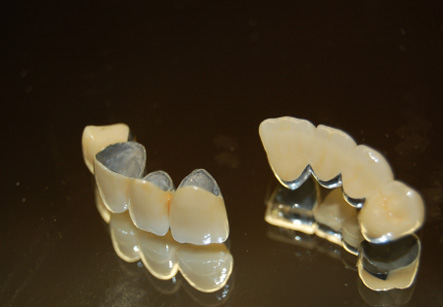PFM Bridge
Introduction
If a missing tooth is present and if the patient follows good oral as well as dental hygiene practices, the prudent choice for the tooth replacement is a bridge.
A dental bridge is a dental technique of restoration utilized for replacement of missing tooth. It adheres to contiguous teeth or other implants. These bridges prevent dental problems like decay of tooth, speech disturbances and shifting teeth. There are several different types of bridges available depending upon the location of the missing teeth, the condition of the surrounding teeth and choice of the patient.
Purpose of a bridge:
The most essential purpose of fixing a dental bridge is for preventing the contiguous teeth from shifting in a place created by missing teeth. This shifting also causes change of bite, sore jaws and problems in the jaw joint. Such uneven bite makes chewing difficult and can cause a person to grind and clench instead. The teeth opposite to a missing tooth can become loose and sometimes extrude from the place. Missing teeth also compromise dental and oral hygiene causing tooth decay and various gum diseases.
Iran offers a superior Dental treatments that is world best quality. For patients from the USA, and Europe for example, the savings can be 60% or more

Porcelain-fused-to-metal (PFM) bridge:
It consists of a metal core inside and a layer of porcelain outside blended together. PFM bridges look just like normal teeth.
The strength, durability and appearance of porcelain fused to metal bridge make it a preferred choice for dental restoration procedures. This type of material is usually used in the molar regions (for back teeth) as it can withstand the extensive biting stresses in this area.
Making of PFM bridge:
In the dental laboratory, the noble metal alloy base is heated to very high temperatures in an oven and it is fused with several layers of porcelain. Porcelain can be fused to metals like platinum, palladium or even gold as well. But for using gold, there should bepresence of enough healthy tooth structure. Using gold means the toughest material and can last for a longer period than any other metal.
Procedure of fitting:
There are several steps in the making of this bridge. First, the dentist examines the teeth and decides that the patient is a candidate for a bridge or not. Once the decision is made, a baseline X-ray film of teeth can be taken. The process goes as given:
• In the first visit, the dentist prepares the teeth on either side of the defect left by a missing tooth. A mild anesthetic medicine is injected to numb the area. Then the cosmetic dentist makes enough space between the teeth on either side so as to accommodate the thickness of the crown. If these teeth already have fillings, they are left in place serving as a foundation for the crown.
• The dentist makes an impression, from which the bridge, false tooth and crowns are made in a dental laboratory. Until the next visit, patient is made to wear a temporary bridge. This temporary bridge protects the teeth and gums till the next visit. Or else, a Flipper appliance is used in the place of missing tooth which can also serve as temporary bridge. A Flipper is a false tooth attached via either a wire or a plastic piece to the roof of the mouth awaiting the permanent bridge.
• On the second visit, the temporary bridge is removed and new permanent bridge is fitted and checked and adjusted for any bite problems. If none, the new bridge is cemented to the teeth permanently.
Advantages:
1. The shade can be matched to the color of existing teeth, unlike pure metal.
2. Most natural appearance of teeth than any other dental bridge material.
3. PFM bridges can be used for both front as well as back teeth.
4. They are durable and have enough strength due to metal.
Disadvantages:
1. The wear on neighboring teeth is more.
2. They are more vulnerable to chipping and breaking than pure metal.
3. Porcelain’s translucence sometimes allow the inside metal core to show through.
4. A dark blue line is visible above the gumline.
5. There are more problems at the gum line, especially if the gums recede with time.